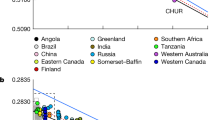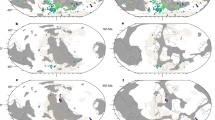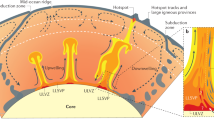Abstract
Most diamonds have been transported to Earth’s surface from depths between ~120 km and ~660 km by volatile-rich magmas called kimberlites. The reconstructed locations of kimberlites erupted in the past 320 million years have been shown to be correlated with seismically imaged large basal mantle structures at ~2,800 km depth. This correlation has been interpreted as requiring basal mantle structures to be stationary over time. However, the geodynamic process responsible for this correlation remains to be identified. Here we use global mantle convection models including a basal layer of dense material and driven by surface plate motions to show that broad mantle upwelling preferentially occurring above basal mantle structures provides the source of heat for kimberlite magmatism. We find that kimberlite eruption locations are statistically as correlated with the mobile basal mantle structures predicted by our models as those imaged by tomographic models, indicating that there is no need to consider basal mantle structures to be stationary. Our models indicate that deep mantle material is carried to the surface by mantle plumes, which is consistent with the geochemical signature of some kimberlites.
This is a preview of subscription content, access via your institution
Access options
Access Nature and 54 other Nature Portfolio journals
Get Nature+, our best-value online-access subscription
$29.99 / 30 days
cancel any time
Subscribe to this journal
Receive 12 print issues and online access
$259.00 per year
only $21.58 per issue
Buy this article
- Purchase on Springer Link
- Instant access to full article PDF
Prices may be subject to local taxes which are calculated during checkout





Similar content being viewed by others
Data availability
Data generated for this study are available at https://doi.org/10.5281/zenodo.7776525 and https://github.com/ofbodur/Kimberlite-magmatism-fed-by-upwelling-above-mobile-basal-mantle-structures. Kimberlite eruption locations and age of emplacement are from ref. 17. Tomographic model depth slices for S40RTS are available at Submachine46, GyPSuM-S is available at https://ds.iris.edu/ds/products/emc-gypsum/, Savani is available at http://www-udc.ig.utexas.edu/external/becker/tdata.html and SEMUCB-WM1 is available at http://seismo.berkeley.edu/~barbara/SEMum2/. Source data are provided with this paper.
Code availability
Codes created for this study are available at https://doi.org/10.5281/zenodo.7776525 and https://github.com/ofbodur/Kimberlite-magmatism-fed-by-upwelling-above-mobile-basal-mantle-structures. The code used to compute the global mantle flow models is available at https://github.com/EarthByte/citcoms. We used Generic Mapping Tools47 (GMT6) for creating maps, Matplotlib48 for plotting, Pandas (1.5.3) Python library49 for model output analysis and ParaView 5.9.1 (ref. 50) for visualization and analysis of mantle flow models.
References
Mitchell, R. H., Giuliani, A. & O’Brien, H. What is a kimberlite? Petrology and mineralogy of hypabyssal kimberlites. Elements 15, 381–386 (2019).
Lewis, H. C. On a diamantiferous peridotite and the genesis of the diamond. Geol. Mag. 4, 22–24 (1887).
O’Reilly, S. Y., Griffin, W. L., Djomani, Y. H. P. & Morgan, P. Are lithospheres forever? GSA Today 11, 4–10 (2001).
Foley, S. F., Yaxley, G. M. & Kjarsgaard, B. A. Kimberlites from source to surface: insights from experiments. Elements 15, 393–398 (2019).
Arndt, N. Komatiites, kimberlites, and boninites. J. Geophys. Res. https://agupubs.onlinelibrary.wiley.com/doi/abs/10.1029/2002JB002157 (2003).
Pasteris, J. D. Kimberlites: Strange bodies? Eos 62, 713–716 (1981).
Pearson, D. G. et al. Hydrous mantle transition zone indicated by ringwoodite included within diamond. Nature 507, 221–224 (2014).
Walter, M. J. et al. Deep mantle cycling of oceanic crust: evidence from diamonds and their mineral inclusions. Science 334, 54–57 (2011).
Mercier, J. C. in The Mantle Sample: Inclusion in Kimberlites and Other Volcanics (eds Boyd, F. R. and Meyer, H. O. A.) 197–212 (AGU, 1979).
Canil, D. & Fedortchouk, Y. Garnet dissolution and the emplacement of kimberlites. Earth Planet. Sci. Lett. 167, 227–237 (1999).
Sparks, R. S. J. et al. Dynamical constraints on kimberlite volcanism. J. Volcanol. Geotherm. Res. 155, 18–48 (2006).
Russell, J. K., Sparks, R. S. J. & Kavanagh, J. L. Kimberlite volcanology: transport, ascent, and eruption. Elements 15, 405–410 (2019).
England, P. & Houseman, G. On the geodynamic setting of kimberlite genesis. Earth Planet. Sci. Lett. 67, 109–122 (1984).
Flament, N., Bodur, Ö. F., Williams, S. E. & Merdith, A. S. Assembly of the basal mantle structure beneath Africa. Nature 603, 846–851 (2022).
Garnero, E. J. & McNamara, A. K. Structure and dynamics of Earth’s lower mantle. Science 320, 626–628 (2008).
Torsvik, T. H., Burke, K., Steinberger, B., Webb, S. J. & Ashwal, L. D. Diamonds sampled by plumes from the core–mantle boundary. Nature 466, 352–355 (2010).
Tappe, S., Smart, K., Torsvik, T., Massuyeau, M. & de Wit, M. Geodynamics of kimberlites on a cooling Earth: clues to plate tectonic evolution and deep volatile cycles. Earth Planet. Sci. Lett. 484, 1–14 (2018).
French, S. W. & Romanowicz, B. A. Whole-mantle radially anisotropic shear velocity structure from spectral-element waveform tomography. Geophys. J. Int. 199, 1303–1327 (2014).
Simmons, N. A., Forte, A. M., Boschi, L. & Grand, S. P. GyPSuM: a joint tomographic model of mantle density and seismic wave speeds. J. Geophys. Res. https://agupubs.onlinelibrary.wiley.com/doi/abs/10.1029/2010JB007631 (2010).
Ritsema, J., Deuss, A., van Heijst, H. J. & Woodhouse, J. H. S40RTS: a degree-40 shear-velocity model for the mantle from new Rayleigh wave dispersion, teleseismic traveltime and normal-mode splitting function measurements. Geophys. J. Int. 184, 1223–1236 (2011).
Auer, L., Boschi, L., Becker, T. W., Nissen-Meyer, T. & Giardini, D. Savani: a variable resolution whole-mantle model of anisotropic shear velocity variations based on multiple data sets. J. Geophys. Res. 119, 3006–3034 (2014).
Merdith, A. S. et al. Extending full-plate tectonic models into deep time: linking the Neoproterozoic and the Phanerozoic. Earth Sci. Rev. 214, 103477 (2021).
Rudolph, M. L. & Zhong, S. J. History and dynamics of net rotation of the mantle and lithosphere. Geochem. Geophys. Geosyst. 15, 3645–3657 (2014).
Zhong, S., McNamara, A., Tan, E., Moresi, L. & Gurnis, M. A benchmark study on mantle convection in a 3-D spherical shell using CitcomS. Geochem. Geophys. Geosyst. https://agupubs.onlinelibrary.wiley.com/doi/abs/10.1029/2008GC002048 (2008).
Bower, D. J., Gurnis, M. & Flament, N. Assimilating lithosphere and slab history in 4-D Earth models. Phys. Earth Planet. Inter. 238, 8–22 (2015).
Flament, N. Present-day dynamic topography and lower-mantle structure from palaeogeographically constrained mantle flow models. Geophys. J. Int. 216, 2158–2182 (2019).
Steinberger, B. & Calderwood, A. R. Models of large-scale viscous flow in the Earth’s mantle with constraints from mineral physics and surface observations. Geophys. J. Int. 167, 1461–1481 (2006).
Arnould, M., Coltice, N., Flament, N. & Mallard, C. Plate tectonics and mantle controls on plume dynamics. Earth Planet. Sci. Lett. 547, 116439 (2020).
Grabreck, A., Flament, N. & Bodur, Ö. F. Mapping global kimberlite potential from reconstructions of mantle flow over the past billion years. PLoS ONE 17, e0268066 (2022).
Davies, D. R., Goes, S. & Sambridge, M. On the relationship between volcanic hotspot locations, the reconstructed eruption sites of large igneous provinces and deep mantle seismic structure. Earth Planet. Sci. Lett. 411, 121–130 (2015).
Kolmogorov, A. Sulla determinazione empirica di una lgge di distribuzione. Inst. Ital. Attuari Giorn. 4, 83–91 (1933).
Pearson, D. G. et al. Deep continental roots and cratons. Nature 596, 199–210 (2021).
Hoggard, M. J. et al. Global distribution of sediment-hosted metals controlled by craton edge stability. Nat. Geosci. 13, 504–510 (2020).
Giuliani, A., Jackson, M. G., Fitzpayne, A. & Dalton, H. Remnants of early Earth differentiation in the deepest mantle-derived lavas. Proc. Natl Acad. Sci. USA 118, e2015211118 (2021).
Hassan, R., Flament, N., Gurnis, M., Bower, D. J. & Müller, D. Provenance of plumes in global convection models. Geochem. Geophys. Geosyst. 16, 1465–1489 (2015).
Jones, T. D., Maguire, R. R., van Keken, P. E., Ritsema, J. & Koelemeijer, P. Subducted oceanic crust as the origin of seismically slow lower-mantle structures. Prog. Earth Planet. Sci. 7, 17 (2020).
Ballmer, M. D., Schumacher, L., Lekic, V., Thomas, C. & Ito, G. Compositional layering within the large low shear‐wave velocity provinces in the lower mantle. Geochem. Geophys. Geosyst. 17, 5056–5077 (2016).
Jaupart, C., Labrosse, S. & Mareschal, J.-C. in Treatise on Geophysics Volume 7: Mantle Dynamics (ed. Bercovici, D.) 253–303 (Elsevier, 2007).
Davies, J. H. & Davies, D. R. Earth’s surface heat flux. Solid Earth 1, 5–24 (2010).
Flament, N. et al. Topographic asymmetry of the South Atlantic from global models of mantle flow and lithospheric stretching. Earth Planet. Sci. Lett. 387, 107–119 (2014).
Burov, E. & Gerya, T. Asymmetric three-dimensional topography over mantle plumes. Nature 513, 85–89 (2014).
Kaufmann, G. & Lambeck, K. Mantle dynamics, postglacial rebound and the radial viscosity profile. Phys. Earth Planet. Inter. 121, 301–324 (2000).
Williams, S., Wright, N. M., Cannon, J., Flament, N. & Müller, R. D. Reconstructing seafloor age distributions in lost ocean basins. Geosci. Front. 12, 769–780 (2021).
Anderson, T. W. & Darling, D. A. Asymptotic theory of certain ‘goodness of fit’ criteria based on stochastic processes. Ann. Math. Stat. 23, 193–212 (1952).
Virtanen, P. et al. SciPy 1.0: fundamental algorithms for scientific computing in Python. Nat. Methods 17, 261–272 (2020).
Hosseini, K. et al. SubMachine: web‐based tools for exploring seismic tomography and other models of Earth’s deep interior. Geochem. Geophys. Geosyst. 19, 1464–1483 (2018).
Wessel, P. et al. The generic mapping tools version 6. Geochem. Geophys. Geosyst. 20, 5556–5564 (2019).
Hunter, J. D. Matplotlib: a 2D graphics environment. Comput. Sci. Eng. 9, 90–95 (2007).
Reback, J. et al. pandas-dev/pandas: Pandas 1.0.5. Zenodo https://doi.org/10.5281/zenodo.3898987 (2020).
Ahrens, J., Geveci, B. & Law, C. in The Visualization Handbook (eds Hansen, C. D. & Johnson, C. R.) 717–731 (Elsevier, 2005).
Acknowledgements
Ö.F.B. and N.F. were supported by Australian Research Council grant LP170100863 (industry partner: De Beers). This research was undertaken with the assistance of resources from the National Computational Infrastructure (NCI), which is supported by the Australian Government. Access to NCI was supported partly by resources and services from the University of Wollongong (UOW). Ö.F.B. acknowledges suggestions by M. Feng about artwork.
Author information
Authors and Affiliations
Contributions
Ö.F.B. contributed to conceptualizing this work, writing the original draft, carrying out revisions and creating visuals and codes. N.F. secured funding for this research and contributed to its conceptualization and to writing and reviewing the paper and revisions.
Corresponding author
Ethics declarations
Competing interests
The authors declare no competing interests.
Peer review
Peer review information
Nature Geoscience thanks Mark Hoggard, Maxwell Rudolph and the other, anonymous, reviewer(s) for their contribution to the peer review of this work. Primary Handling Editors: Rebecca Neely and Louise Hawkins, in collaboration with the Nature Geoscience team.
Additional information
Publisher’s note Springer Nature remains neutral with regard to jurisdictional claims in published maps and institutional affiliations.
Extended data
Extended Data Fig. 1 Temperature and viscosity profiles in Case 1.
(a) Horizontal-average of the temperature profile (black line) between 200 Ma and present-day with error bars (red). (b) The horizontally-averaged viscosity profile at 180 Ma (black line) is shown with maximum and minimum viscosities at each depth.
Extended Data Fig. 2 Subduction zones at 1 Ga.
Slabs are inserted down to 1,000 km depth from reconstructed subduction zones (red lines)50. Reconstructed cratonic blocks are shown as shaded polygons22.
Extended Data Fig. 3 Distance to LLSVPs and whole mantle averaged radial heat advection in mantle flow models.
Angular distance to LLSVP near the base of the mantle at 180 Ma at indicated depths are shown for tomographic models (a) S40RTS20, (b) GyPSuM-S19, (c) Savani21 and (d) SEMUCB-WM118 (filtered to spherical harmonic degree lmax = 12). The boundaries of LLSVPs are determined by the contour δVs = −0.3% (−0.1% for SEMUCB-WM1 (lmax = 12) due to a decrease in power after filtering) and the distance is equal to zero within the contour. Reconstructed cratonic shapes are shown in grey polygons. Angular distance to the depth-averaged RHA \(\bar J(\theta ,\varphi )\) (between 322 km and 2,867 km depths) is shown for Cases 1-4 (e-h) at 180 Ma, with the distance is equal to zero within the contour \(\bar J = 1\;{{{\mathrm{K}}}}\;{{{\mathrm{m}}}}\;{{{\mathrm{yr}}}}^{ - 1}\).
Extended Data Fig. 4 Radial heat advection in the upper and lower mantle.
Radial heat advection \(\bar J(\theta ,\varphi )\) ≥ 1 K m yr−1 at 180 Ma for Case 1, averaged for a) upper mantle depths and b) lower mantle depths.
Extended Data Fig. 5 Fractional area of RHA in Case 1 at 180 Ma and of LLSVPs in tomographic models.
Fractional area covered by the depth-averaged radial heat advection field in Case 1 at 180 Ma and by LLSVP defined by δVs (%) contours in tomographic models for indicated depths at the base of the mantle.
Extended Data Fig. 6 Depth-averaged radial heat advection over time.
Radial heat advection averaged between 322 km and 2,867 km \(\bar J(\theta ,\varphi )\) shown at (a) 200 Ma, (b) 160 Ma, (c) 140 Ma, (d) 120 Ma, (e) 100 Ma, (f) 80 Ma, (g) 60 Ma and (h) 40 Ma overlain by reconstructed cratonic blocks22 and kimberlites (coloured circles).
Extended Data Fig. 7 Comparison of mean distance to reconstructed kimberlites over time and K-S statistical rates in capturing kimberlite emplacement over time for mantle flow model Case 1 and tomographic models.
(a-b) Mean distances (with one standard deviation shown as one-sided error bars) between radial heat advection averaged between 322 km and 2,867 km \(\bar J(\theta ,\varphi )\) for Case 1 and its K-S statistical test is compared with mean distances (and their statistics) between LLSVPs imaged by tomographic models GyPSuM-S and Savani and reconstructed kimberlites over time. Sample size is given in (a). (c) Success rates of K-S statistical test with varying dVs(%) contours in different tomographic models which give the same fractional area as Case 1 for each time. (d-e) Mean distances and K-S tests for Case 1 as well as fixed RHA \(\bar J(\theta ,\varphi ,t)|_0^{t = 200\;Ma}\) time averaged between 200 Ma and 0 Ma.
Extended Data Fig. 8 Distance and statistical relationships between reconstructed kimberlite eruption locations and the nearest hot mantle upwelling for geodynamic model Cases 1-4.
(a,b) Mean distances between reconstructed kimberlites and (a) whole mantle, upper mantle, and lower mantle averaged RHA for Case 1, and (b) whole mantle averaged RHA for Cases 1-4 with shown with one sided error bars. Sample size is given in (a). The Kolmogorov-Smirnov statistical test success out of 1,000 random iterations is shown as a percentage for (c) different depth averages of RHA for Case 1 and (d) whole mantle depth averages or RHA for all Cases 1-4.
Extended Data Fig. 9 Sensitivity to lithospheric thickness.
(a) Lithospheric blocks22,32 used for the statistical analysis. The silver-coloured polygons are from ref. 22 for which the statistical results are presented in Fig. 3b. The green-coloured polygons are determined from lithosphere thicker than 150 km (ref. 32,33). Kimberlite eruption locations are shown in black. (b) Mean distances to kimberlites + one standard deviation shown as one-sided error bars and (c) K-S statistical test results for four tomographic models using only lithosphere thicker than 150 km. Sample size is given in (b).
Extended Data Fig. 10 Ascent of basal mantle material (BMM) tracers over time.
Horizontally averaged tracer volume is given relative to the base of the mantle over time between 1 Ga and present day for (a) Case 2 (+1.44 %), (b) Case 1 (+1.00 %) and (c) Case 3 (+0.00 %). The time interval is 20 Myr for Cases 1-2, and 40 Myr for Case 3.
Supplementary information
Supplementary Information
Captions for Supplementary Videos 1–5 and caption for Supplementary Table 1.
Supplementary Table 1
Chemically distinct kimberlites.
Supplementary Video 1
Kimberlite emplacement and 3D radial heat advection for hot mantle upwellings for the reference model (Case 1).
Supplementary Video 2
Kimberlite emplacement and 3D radial heat advection for hot mantle upwellings for Case 2.
Supplementary Video 3
Kimberlite emplacement and 3D radial heat advection for hot mantle upwellings for Case 3.
Supplementary Video 4
Kimberlite emplacement and 3D radial heat advection for hot mantle upwellings for Case 4.
Supplementary Video 5
Kimberlite emplacement and depth-averaged radial heat advection in the upper and lower mantles for Case 1.
Source data
Source Data Fig. 2
Statistical source data.
Source Data Extended Data Fig. 4
Statistical source data.
Source Data Extended Data Fig. 6
Statistical source data.
Rights and permissions
Springer Nature or its licensor (e.g. a society or other partner) holds exclusive rights to this article under a publishing agreement with the author(s) or other rightsholder(s); author self-archiving of the accepted manuscript version of this article is solely governed by the terms of such publishing agreement and applicable law.
About this article
Cite this article
Bodur, Ö.F., Flament, N. Kimberlite magmatism fed by upwelling above mobile basal mantle structures. Nat. Geosci. 16, 534–540 (2023). https://doi.org/10.1038/s41561-023-01181-8
Received:
Accepted:
Published:
Issue Date:
DOI: https://doi.org/10.1038/s41561-023-01181-8



